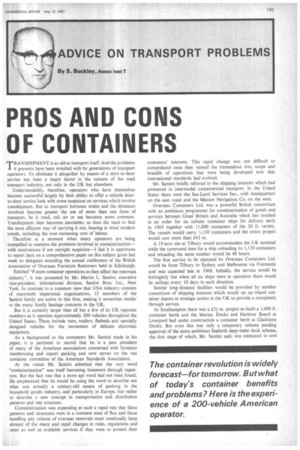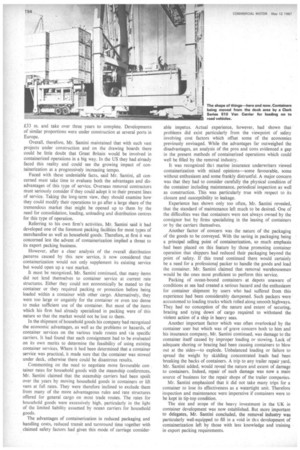PROS AND CONS OF CONTAINERS
Page 195

Page 196

If you've noticed an error in this article please click here to report it so we can fix it.
TRANSHIPMENT is as old as transport itself. And the problems it presents have been wrestled with by generations of transport operators. To eliminate it altogether by means of a door-to-door service has been a major factor in the success of the road transport industry, not only in the UK but elsewhere.
Understandably, therefore, operators who have themselves become successful largely by their ability to offer a reliable door to-door service look with some suspicion on services which involve transhipment.. But as transport horizons widen and the distances involved become greater the use of more than one form of transport, be it road, rail, air or sea becomes more common. Transhipment then becomes inevitable; so does the need to find the most efficient way of carrying it out, bearing in mind modern trends, including the ever-increasing cost of labour.
Therefore at a moment when many operators are being compelled to examine the problems involved in containerization—
with reservations if not outright suspicion—I feel it is opportune to report here on a comprehensive paper on this subject given last week to delegates attending the annual conference of the British Association of Overseas Furniture Removers held in Edinburgh.
Entitled "Future container operations as they affect the removals industry", it was presented by Mr. Martin L. Santini, executive vice-president, international division, Santini Bros. Inc., New York. In contrast to a common view that USA industry consists of mammoth impersonal organizations, 15 members of the Santini family are active in this firm, making it somewhat similar to the many family haulage concerns in the UK. • But it is certainly larger than all but a few of its UK opposite numbers as it operates approximately 200 vehicles throughout the United States. These include vans, trailers, flatbeds and specially designed vehicles for the movement of delicate electronic equipment.
As a background to the comments Mr. Santini made in his paper, it is pertinent to record that he is a past president of many of the American associations concerned with furniture warehousing and export packing and now serves on the van container committee of the American Standards Association.
At the outset Mr. Santini admitted that the very word "containerization" was itself becoming timeworn through repeti tion. But the fact was that a more apt word had not been found.
He emphasized that he would be using the word to describe not what was actually a century-old means of packing in the household goods industry, and particularly in Europe, but rather to describe a new concept in transportation and distribution patterns and rate structure.
Containerization was expanding at such a rapid rate that these patterns and structures were in a constant state of flux and those handling any volume of overseas removals must continually keep abreast of the many and rapid changes in rules, regulations and rates as well as available services if they were to protect their customers' interests. This rapid change was not difficult to comprehend once they viewed the tremendous size, scope and breadth of operations that were being developed now that international standards had evolved.
Mr. Santini briefly referred to the shipping interests which had pioneered in intermodal containerized transport. In the United States there were the Sea-Land Services Inc.,.with headquarters on the east coast and the Matson Navigation Co. on the west.
Overseas Containers Ltd. was a powerful British consortium with an ambitious programme for containerization of goods and services between Great Britain and Australia which has resulted in an order for six cellular container ships for delivery early in 1969 together with 11,000 containers of the 20 ft. variety. The vessels would carry 1,130 containers and the entire project would cost more than £42 m.
A 19-acre site at Tilbury would accommodate the UK terminal while the turnround time for a ship unloading its 1,130 containers and reloading the same number would be 48 hours.
The first service to be operated by Overseas Containers Ltd. would be from Tilbury to Sydney and Melbourne via Fremantle and was expected late in 1968. Initially, the service would be fortnightly but when all six ships were in operation there would be sailings every 10 days in each direction.
Similar long-distance facilities would be provided by another consortium of shipping interests which would set up inland container depots at strategic points in the UK to provide a completely, through service.
At Southampton there was a £2+ m. project to build a 1,000 ft..
container -berth and the Mersey Docks and Harbour Board at Liverpool had under construction a container berth at Gladstone
Docks. But even this was only a temporary scheme pending approval of the more ambitious Seaforth deep-water dock scheme, the first stage of which, Mr. Santini said, was estimated to cost £33 tn and take over three years to complete. Developments of similar proportions were under construction at several ports in Europe.
Overall, therefore, Mr. Santini maintained that with such vast projects under construction and on the drawing boards there could be little doubt that Great Britain would be involved in containerized operations in a big way. In the US they had already faced this reality and could see the growing impact of containerization at a progressively increasing tempo.
Faced with these undeniable facts, said Mr. Santini, all concerned must take time to evaluate both the advantages and disadvantages of this type of service. Overseas removal contractors must seriously consider if they could adopt it to their present lines of service. Taking the long-term view, they should examine how they could modify their operations to go after a large share of the tremendous market that might be opened up to them by the need for consolidation, loading, unloading and distribution centres for this type of operation.
Referring to his own firm's activities, Mr. Santini said it had developed one of the foremost packing facilities for most types of merchandise as well as household goods. Therefore, at first it was concerned lest the advent of containerization implied a threat to its export packing business.
However, after a clear analysis of the overall distribution patterns caused by this new service, it now considered that containerization would not only supplement its existing service but would open up a vast market.
It must be recognized, Mr. Santini continued, that many items did not lend themselves to container service at current rate structures. Either they could not economically be mated to the container or they required packing or protection before being loaded within a container with other cargo. Alternatively, they were too large or ungainly for the container or even too dense to make sufficient use of the container. But most of the items which his firm had already specialized in packing were of this nature so that the market would not be lost to them.
In the shipment of household goods his company had recognized the economic advantages, as well as the problems or hazards, of container services on the various trade routes and ‘ia specific carriers. It had found that each consignment had to be evaluated on its own merits to determine the feasibility of using existing container services. Where it had been determined that a container service was practical, it made sure that the container was stowed under deck, otherwise there could be disastrous results.
Commenting on the need to negotiate more favourable con-, tamer rates for household goods with the steamship conferences, Mr. Santini claimed that the steamship carriers had been spoilt over the years by moving household goods in containers or lift vans at full rates. They were therefore inclined to exclude them from many of the more advantageous rules and rate structures offered for general cargo on most trade routes. The rates for household goods were excessively high, particularly in the light of the limited liability assumed by ocean carriers for household goods.
The advantages of containerization in reduced packaging and handling costs, reduced transit and turnround time together with claimed safety factors had given this mode of carriage consider
able impetus. Actual experience, however, had shown that problems did exist particularly from the viewpoint of safety involving cost factors which offset some of the economies previously envisaged. While the advantages far outweighed the disadvantages, an analysis of the pros and cons evidenced a gap in the present methods of containerized operations which could well be filled by the removal industry.
It was recognized thz t marine insurance underwriters viewed containerization with mixed opinions—some favourable, some without enthusiasm and some frankly distrustful. A major concern was that they had to consider carefully the physical condition of the container including maintenance, periodical inspection as well as construction. This was particularly true with respect to its closure and susceptibility to leakage.
Experience has shown only too often, Mr. Santini revealed, that the standard of maintenance left much to be desired. One of the difficulties was that containers were not always owned by the consignor but by firms specializing in the leasing of containers or by the carriers themselves.
Another factor of concern was the nature of the packaging of the goods to be conveyed. With the saving in packaging being a principal selling point of containerization, so much emphasis • had been placed on this feature by those promoting container operation that shippers had reduced their packaging beyond the point of safety. If this trend continued there would certainly be a need for a professional packer to handle the goods and load the container. Mr. Santini claimed that removal warehousemen would be the ones most proficient to perform this service. .
Packing of ocean-bound containers at depots unaware of conditions at sea had created a serious hazard and the enthusiasm for container shipment by users who had suffered from this experience had been considerably dampened. Such packers were accustomed to loading trucks which rolled along smooth highways. They had no conception of the nature and extent of securing, bracing and tying down of cargo required to withstand the violent action of a ship in heavy seas.
Another important factor which was often overlooked by the container user but which was of grave concern both to him and his insurance company, Mr. Santini continued, was damage to the container itself caused by improper loading or stowing. Lack of adequate shoring or bracing had been causing containers to blow out at the sides—to explode. Unbalanced loading or failure to spread the weight by skidding concentrated loads had been breaking the backs of containers. A trip to any trailer repair yard, Mr. Santini added, would reveal the nature and extent of damage to containers. Indeed, repair of such damage was now a main source of business for the repair shops of the trailer companies.
Mr. Santini emphasized that it did not take many trips for a container to lose its effectiveness as a watertight unit. Therefore inspection and maintenance were imperative if containers were to be kept in tip-top condition.
The size and scope of the heavy investment in the UK in container development was now established. But more important to delegates, Mr. Santini concluded, the removal industry was particularly well-equipped to fill in a void in this development of containerization left by those with less knowledge and training in export packing requirements.
















































































































































































































































